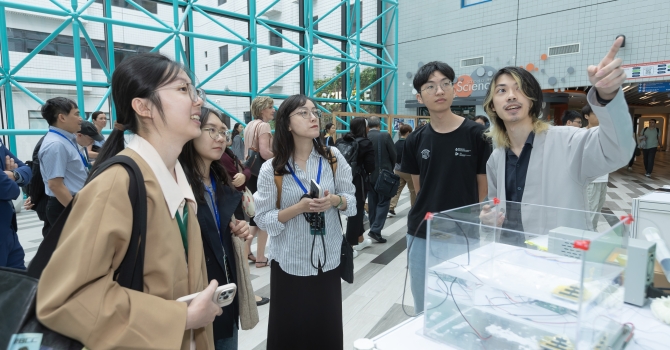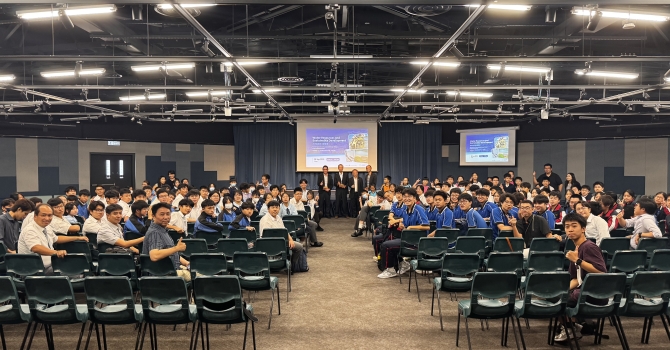Exploring the Future of Smart Buildings: Highlights from the HKUST BIPV Seminar
-
BIPV is key for future smart, low-carbon cities, integrating solar power directly into building materials for both energy generation and improved building performance.
-
New materials and technologies—like thin-film and colored PV glass—are driving BIPV innovation, making solar integration more efficient and aesthetically flexible.
-
Policy support and collaboration are accelerating BIPV adoption, but further efforts are needed to maximize its potential and impact.
As cities worldwide race toward carbon neutrality and smarter, more resilient urban environments, the integration of renewable energy into the very fabric of our buildings is no longer a distant vision—it is happening now. Our Living Labs team had the recent pleasure to co-lead a dynamic seminar about the building-integrated Photovoltaic (BIPV) technology by Prof. Peng Shou, Prof. Yang Hongxing, and Prof. Xiang Changying on 9 September 2025.
Setting the Stage: Vision for Net-Zero and Smart Cities
The seminar opened with an inspiring vision for the future of cities—one where buildings are not just passive structures but active participants in energy generation and management. Speakers emphasized that BIPV will be a cornerstone of smart city infrastructure, enabling buildings to communicate with energy grids, storage systems, and IoT platforms. The audience learned how next-generation BIPV elements will do more than generate electricity; they will also provide thermal insulation, daylighting, and even self-cleaning or noise-reducing properties. There was palpable excitement as experts described how BIPV could empower buildings in remote or disaster-prone areas, reducing reliance on external infrastructure and supporting resilient communities.
HKUST as a Living Lab: Real-World Innovation
A highlight of the seminar was the showcase of HKUST’s own campus as a “Living Lab” for sustainable innovation. Attendees heard about the university’s flagship BIPV demonstration at the Tower D Staff Quarters, where advanced colored solar panels are being retrofitted onto building façades. This project, led by Prof. Changying Xiang, is not only a technical milestone—being Hong Kong’s first color BIPV wall renovation—but also a powerful symbol of the city’s commitment to its 2050 zero-carbon goal. The seminar buzzed with discussion as participants learned that HKUST’s broader sustainability initiatives now include over 7,500 solar panels across more than 50 campus locations, all integrated with smart building systems and advanced materials research. These efforts have turned the campus into a hub for education, research, and industry collaboration.
Hong Kong and Mainland China: Leading by Example
The seminar also spotlighted how Hong Kong and Mainland China are at the forefront of BIPV adoption. Case studies ranged from medium-scale installations in government and commercial buildings to pioneering projects at institutions like Hong Kong Polytechnic University, which has become a leader in BIPV research and public education. Mainland China’s ambitious projects, such as the massive BIPV installation at Nanjing South Railway Station and innovative applications in Guangzhou and Shanghai, were presented as proof of BIPV’s scalability and versatility. These stories illustrated how BIPV is being woven into the fabric of both new and existing buildings, supporting smart energy management and significant carbon reductions.
Global Inspiration and Technological Progress
International best practices were also discussed, with Germany’s “100,000 Roofs” program and BIPV installations in airport terminals and smart city projects serving as inspiration for local efforts. The seminar’s atmosphere was one of optimism as speakers described how advances in thin-film, perovskite, and transparent PV materials are expanding the possibilities for BIPV—making it suitable for windows, skylights, and even curved surfaces. The integration of BIPV with smart building management systems was highlighted as a key enabler for real-time energy optimization and the achievement of net-zero carbon buildings.
Benefits, Challenges, and Policy Support
Throughout the day, the conversation balanced enthusiasm with realism. While the benefits of BIPV—such as dual functionality, energy and carbon savings, and aesthetic flexibility—were celebrated, speakers also acknowledged ongoing challenges. High upfront costs, integration complexity, and regulatory hurdles remain, but the mood was hopeful as policy initiatives like Hong Kong’s feed-in tariff scheme and green building incentives were discussed. The seminar concluded with a call to action: continued collaboration between government, industry, and academia is essential to unlock the full potential of BIPV and accelerate the transition to sustainable, smart cities.
A Campus Living the Future
As the seminar wrapped up, participants toured HKUST’s Sustainable Smart Campus, witnessing firsthand the real-world impact of the ideas discussed. From algae-based carbon capture and food waste recycling to vertical gardens and nano-coating sites that boost solar panel efficiency, the campus stood as a testament to what’s possible when innovation, research, and community engagement come together. The event left attendees inspired and energized, ready to play their part in building a net-zero, smarter future for Hong Kong and beyond.



